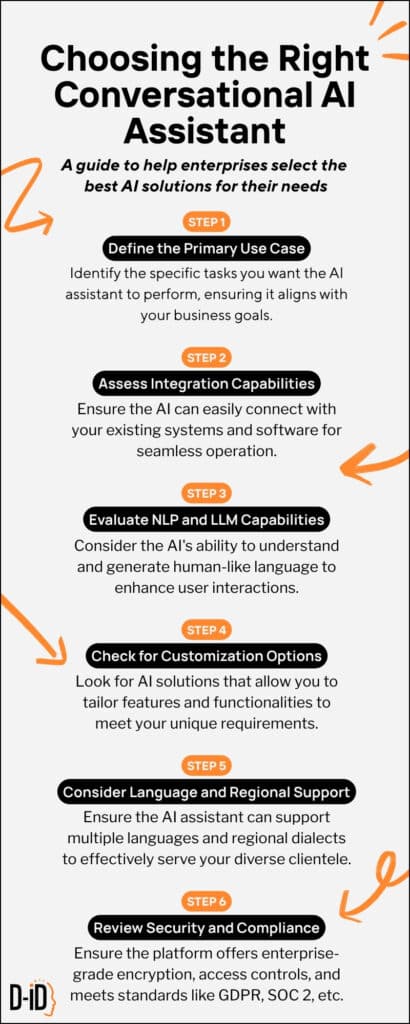Choosing the Right Conversational AI Assistant for Your Enterprise
Key Takeaways
- A conversational AI assistant helps enterprises automate communication through real-time, natural interactions.
- These assistants go beyond basic chatbots by handling complex queries, maintaining context, and supporting voice or avatar-based interactions.
- D-ID’s conversational AI avatars add a visual, branded layer to enterprise communication making assistants more human and engaging.
What Is a Conversational AI Assistant?
A conversational AI assistant is a virtual interface that allows users to interact with software or services through natural language, typically via chat, voice, or both. Unlike traditional chatbots, which follow rigid decision trees, conversational AI assistants use natural language processing (NLP), large language models (LLMs), and machine learning to understand context and generate dynamic responses.
This makes them far more capable and flexible than early-generation bots. A chatbot might recognize a keyword and serve a canned response. An AI conversation assistant can understand intent, engage in multi-turn conversations, and tailor its responses based on previous user input.
In enterprise environments, conversational AI virtual assistants are used across a wide range of applications:
- Customer service
- Sales engagement
- Internal IT or HR support
- Product tutorials or demos
- Self-service portals
They can be embedded in websites, mobile apps, support widgets, or voice-enabled devices. When paired with real-time video and branded avatars, they become a full-fledged interface; something that doesn’t just respond, but actually represents your company in real time.
What are the Benefits of Using AI Conversation Assistants?
The appeal of conversational AI for enterprises goes beyond novelty. These assistants offer measurable improvements to operations, customer satisfaction, and team productivity.
24/7 Availability
An AI conversation assistant never sleeps. This is ideal for global businesses that support users across time zones. Customers can get help, place orders, or check account information anytime without waiting in line.
Reduced Workload for Support Teams
By handling common questions, basic troubleshooting, or status checks, a conversational AI assistant frees up human agents to focus on high-value tasks. This leads to faster resolution times and happier teams.
Improved Customer Experience
With the ability to personalize responses and maintain conversation history, these assistants make customers feel seen and heard. They don’t repeat questions or give robotic replies. Instead, they adapt based on tone, language, and context.
Scalability Across Channels
AI assistants can be deployed across multiple channels at once: your website, app, messaging platforms, and even smart devices. This makes it easy to offer a consistent experience across every digital touchpoint.
Multilingual Support
Enterprise users often span countries and languages. A conversational AI virtual assistant can automatically detect the user’s language and deliver localized responses with native tone and syntax.
Consistency of Information
Once trained or integrated with internal knowledge sources, the assistant consistently delivers accurate and up-to-date information. There’s no variation between shifts or teams.
Analytics and Continuous Learning
AI online chatbots gather valuable data on user behavior, pain points, and intent. This data can be used to improve not just the assistant, but your products, support processes, and website UX.
These benefits combine to create a smarter, more scalable customer and employee experience. As more enterprise systems become AI-enabled, assistants become the bridge between humans and complex digital infrastructure.
Choosing the Right AI Assistant for Your Enterprise

Selecting a conversational AI assistant is not a one-size-fits-all decision. Enterprises should consider several factors before choosing a solution or platform.
Define the Primary Use Case
Start by clarifying what you need the assistant to do. Is it for customer support? Lead qualification? Employee onboarding? Each use case may require different skills, integrations, and delivery styles.
Assess Integration Capabilities
Your assistant should connect easily with your current tech stack. Look for support for APIs, CRMs, ticketing platforms, content management systems, and authentication protocols. The more integrated the assistant is, the more powerful and helpful it becomes.
Evaluate NLP and LLM Capabilities
A good assistant understands language at a deep level. It should be able to recognize varied inputs, handle slang or typos, and respond with coherent, contextual replies. Test for multi-turn conversation flow and adaptability.
Check for Customization Options
Does the platform allow you to customize the assistant’s personality, tone, and appearance? Can you align it with your brand’s values? Look for platforms that support multiple AI styles, from formal and concise to friendly and expressive.
Consider Language and Regional Support
If you’re serving international users, make sure the assistant can switch languages on the fly. Look for options to localize not just text, but tone, idioms, and visuals.
Review Security and Compliance
For industries with regulatory requirements, security is key. Ensure the platform offers enterprise-grade encryption, role-based access controls, and audit logs. Check for compliance with standards like GDPR, HIPAA, or SOC 2.
Think About the Interface
Is the assistant just text-based? Does it support voice, video, or avatar components? The interface matters, especially if you want to create a branded experience that users will remember.
When these criteria are met, the result is a conversational AI assistant that fits seamlessly into your digital ecosystem and drives measurable results from day one.
D-ID’s Conversational AI Avatar Solutions
D-ID brings a new dimension to AI conversation assistants: the face. Our technology lets you create lifelike, talking avatars that combine the intelligence of an LLM with the presence of a human presenter. This transforms the assistant from a utility into a brand ambassador.
Key Capabilities:
- Avatar-Led Conversations
- Instead of showing only text responses, the assistant appears on screen as a speaking avatar. This visual element adds emotion, builds trust, and strengthens the connection between brand and user.
- Text-to-Video in Real Time
- D-ID’s avatars use a real-time video engine that synchronizes facial expressions and lip movement with synthetic speech, delivering a smooth and believable interaction.
- Multilingual Support
- Avatars can speak over 100 languages and dialects, adapting tone and delivery based on location and cultural expectations. This allows companies to offer localized experiences at scale.
- Agent Framework
- D-ID avatars can be connected to CRMs, product databases, and internal knowledge systems. This integration enables them to deliver accurate, personalized answers in enterprise environments. Learn more in our AI Agents overview.
- Flexible Embedding
- Avatars integrate easily with websites, apps, and kiosks using standard APIs and SDKs. They load quickly, respond in real time, and maintain performance across devices.
The conversational AI assistant becomes a digital face for your brand. It’s not just a voice or a block of text, it’s a real-time, responsive presence that builds trust, explains complex topics, and invites interaction.
Next Steps: Build Your AI Assistant With a Human Touch
Your customers expect clarity, empathy, and quick results. Your team wants tools that help them scale. A conversational AI virtual assistant delivers both.
D-ID empowers your business to:
- Create AI online chatbots that listen, learn, and speak naturally
- Add expressive, customizable avatars for a stronger emotional connection
Localize messaging across languages and platforms - Integrate securely with your existing tools and workflows
If you’re ready to build a smarter interface with a more human feel, book a call with our team or start exploring our avatar-driven AI Agent Framework. The right assistant is waiting.
FAQs
-
A conversational AI assistant is a more advanced version of a chatbot. While chatbots often rely on predefined scripts and keyword matching, AI assistants use natural language processing and generative models to understand context and carry out multi-turn conversations. They can answer complex questions, retain user context, and adapt their responses on the fly. Some assistants also include voice or avatar capabilities, which offer a more human and immersive interaction than standard text-based bots.
-
Conversational AI assistants enhance customer service by providing immediate, accurate, and personalized support at any hour. They reduce response times, free up human agents for more complex issues, and ensure consistency across interactions. These assistants can guide users through troubleshooting steps, answer FAQs, and escalate to live agents when necessary. For enterprises, this results in lower operational costs, better customer satisfaction, and a support system that can scale with demand across time zones and regions.
-
Companies should evaluate the assistant’s language capabilities, integration options, customization features, and real-time performance. It is important to consider how well the assistant reflects the company’s brand identity, including tone of voice and user experience. Security, multilingual support, and performance analytics are also key. Whether the assistant is text-based, voice-enabled, or paired with a visual avatar, it should meet technical requirements and enhance the overall user journey from start to finish.
-
D-ID’s solution brings together conversational intelligence and lifelike video avatars, allowing enterprises to create branded digital assistants that speak and respond naturally. These avatars can be embedded into websites, applications, or support tools through simple integrations. They support real-time communication in multiple languages and offer customizable visual styles and personalities. With seamless API connectivity and access to knowledge bases or CRM systems, D-ID provides a complete solution for scalable, visual AI assistants in any industry.
-
Yes. Most modern conversational AI assistants are built with multilingual capabilities, allowing them to switch languages automatically based on user input or preferences. Assistants powered by D-ID can speak in over 100 languages and adjust tone, pacing, and phrasing to suit different cultural or professional contexts. Whether addressing a customer in English, Spanish, or Mandarin, or adjusting between a formal and casual tone, the assistant can maintain clarity and connection throughout the interaction.
Was this post useful?
Thank you for your feedback!
 Libi Michelson
Libi Michelson